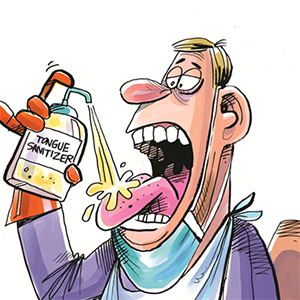Sports
/ArcaMax

Minnesota Wild win in overtime at Vancouver, keep playoff hopes percolating
VANCOUVER, British Columbia – The Minnesota Wild still haven’t clinched a playoff spot, but they’re getting closer.
Their 3-2 overtime rally over the Vancouver Canucks on Saturday night at Rogers Arena lifted them to 95 points, one ahead of the St. Louis Blues and five in front of the Calgary Flames in the battle for the two Western ...Read more

Seattle Kraken topple St. Louis Blues in shootout
SEATTLE — Kraken 4, Blues 3, SO at Climate Pledge Arena
Notable: There were plusses and negatives on Saturday night, but the fans went home happy. In their second-to-last game of the season, the Kraken picked up a pair of standings points that could hurt their draft placement and prevailed in a seven-round shootout.
The Kraken’s Finnish ...Read more
Knights clinch Pacific title, beat Predators in Marchessault's return
LAS VEGAS — The Vegas Golden Knights clinched their fourth Pacific Division title in eight seasons with a 5-3 win over the Nashville Predators at T-Mobile Arena on Saturday.
Defenseman Noah Hanifin broke the tie with 1:55 remaining after Nashville scored twice in the third.
It was the Knights’ 45th regulation win this season, giving them ...Read more

Panthers outlast Sabres in shootout, keep faint hopes alive of hosting a first-round playoff series
SUNRISE, Fla. — The Florida Panthers’ long shot home ice hopes have extended into the final week of the NHL season because their backup goalie played like a top-flight starter Saturday and their unconventional shootout lineup did just enough to eke out the team’s third win in a row.
The No. 1 reason the Panthers survived the Buffalo ...Read more

Hurricanes tie franchise home win record, eliminate Rangers from playoffs
RALEIGH, N.C. — Success, in Carolina Hurricanes parlance, is often defined as “2006.” That season — the end of which resulted in the Canes’ lone Stanley Cup championship — has been the measure by which all subsequent seasons have been judged.
There were, after another run in 2009, the “dark times,” also known as “BB” — ...Read more
Depleted Avalanche drops second straight, falls to Kings in penultimate regular-season game
LOS ANGELES — The Colorado Avalanche cruised past the Los Angeles Kings two weeks ago and was one of the hottest teams in the NHL.
A lot has changed since then, but parsing out how much concern to have about the recent middling performances is not easy.
A team that did not look very much like the one that defeated the Kings by four goals ...Read more

Bobby Brink plays hero behind Tyson Foerster's two goals in Flyers' shootout win over Islanders
PHILADELPHIA — There’s a faction of Flyers fans out there who want the team to lose games down the stretch, and look, it’s not entirely misguided.
But when the team’s young players start putting it together the way the Flyers did on Saturday, how can you be mad about the results?
“We’re still trying to work on our our own games, ...Read more

Panthers' Aaron Ekblad talks suspension, preparation for playoffs
SUNRISE, Fla. — For a little more than four weeks, Aaron Ekblad had to be away from the Florida Panthers.
That’s part of the punishment that came with the defenseman’s 20-game suspension for violating the terms of the NHL and NHL Players Association’s performance enhancing substances program, which came via a failed random drug test.
...Read more
Minnesota Wild crash against Calgary Flames, shunt their playoff prospects into shaky territory
CALGARY, Alberta – Much like getting this far, after all the injuries and inconsistency, finalizing a playoff berth isn’t easy for the Minnesota Wild.
They blew a chance to clinch Friday night by getting dumped 4-2 by the Calgary Flames at Scotiabank Saddledome to continue the three-team race for the two wild cards in the Western Conference...Read more
Familiar issue haunts San Jose Sharks in loss to Edmonton Oilers
The San Jose Sharks could not stay out of the penalty box on Friday night against the Edmonton Oilers, and it cost them any chance of ending their extended losing streak.
The Sharks took five penalties against the Oilers – all stick fouls — including Alexander Wennberg’s borderline tripping call at the 5:54 mark of the third period. Just ...Read more

Sidney Crosby gets winner as Penguins rally from 2 goals down to beat Devils
After an awful start at Prudential Center in Newark, N.J., on Friday, the Penguins stabilized then rallied to earn a 4-2 win over the playoff-bound New Jersey Devils.
Sidney Crosby scored the winner after the Penguins erased a multi-goal deficit.
From one knee, the captain steered a slap pass from Bryan Rust into an open cage with 6:39 left in...Read more

Red Wings' slim playoff hopes still alive after Kasper's OT goal vs. Lightning
TAMPA, Fla. — The Red Wings needed a victory to stay alive and the rookie saved them.
Marco Kasper had two goals and an assist, including the overtime winner at 3 minutes, 20 seconds, giving the Wings a 4-3 victory over Tampa.
Kasper drove in from the wing against a tired group of Lightning skaters and beat goaltender Andrei Vasilevskiy for ...Read more

Gabe Landeskog to play for AHL's Eagles in first game action since 2022
DENVER — Gabe Landeskog did not dress for a hockey game for 1,020 days. That streak ends Friday night.
Landeskog will be in the lineup for the Colorado Eagles in an AHL contest at Blue Arena in Loveland against the Henderson Silver Knights. He has not played since June 26, 2022, when the Colorado Avalanche captain became the first player to ...Read more
Golden Knights hold off Kraken, inch closer to Pacific title
LAS VEGAS — The celebration has been put on hold for at least one more night, but the Vegas Golden Knights are on the doorstep of the Pacific Division title.
The Knights got half of what they needed to clinch, a 2-1 regulation win over the Seattle Kraken on Thursday at T-Mobile Arena.
The other half did not materialize, as the Los Angeles ...Read more

Short-handed Avalanche drops home finale to Canucks
DENVER — The next hockey game at Ball Arena will have much bigger stakes, thankfully.
Short five regulars due to injury, including the reigning MVP, the Colorado Avalanche dropped a 4-1 decision to the Vancouver Canucks in the final home game of its regular season Thursday night.
The Nathan MacKinnon-less Avs looked like a team that didn’t...Read more
Panthers rounding into form ahead of playoffs, overcome early deficit to beat Red Wings
SUNRISE, Fla. — The Florida Panthers need a lot to go their way over this next week for their outside chance of opening the Stanley Cup playoffs on home ice to become a reality.
They did their part on Thursday, overcoming an early deficit to beat the Detroit Red Wings, 3-1, at Amerant Bank Arena.
Florida is now 46-29-4, its 96 points one shy...Read more

Bruins fall to Blackhawks, 5-2
BOSTON — The Bruins’ late season dive toward the highest draft pick possible got back on track on Thursday night at TD Garden.
After scoring a season-high seven goals in a win over the New Jersey Devils, the B’s allowed three goals in 1:33 at the start of the third period and fell to the lowly Chicago Blackhawks, 5-2, as a trio of former ...Read more
McDavid returns to action, leads Oilers past Blues 4-3
Oilers superstar Connor McDavid returned to action for the first time since March 20 on Wednesday night, and the Blues were not thrilled to see him back.
McDavid assisted on three goals -- including Connor Brown's game-winner with 20.4 seconds left -- as the Oilers edged the Blues 4-3 in Edmonton.
The Blues got goals from Jordan Kyrou, Pavel ...Read more

Hot off IR, Kirill Kaprizov and Joel Eriksson Ek carry Wild to nail-biting victory over Sharks
ST. PAUL, Minn. — Kirill Kaprizov and Joel Eriksson Ek weren’t supposed to carry the Wild in their return to action after being sidelined for six weeks injured, even longer in Kaprizov’s case.
In getting their best player and most indispensable forward back, the new-look Wild could start to rediscover their old-school ways by establishing...Read more

Tyson Foerster nets first career hat trick as Flyers win goal-fest vs. Rangers, 8-5
After going an entire month without a regulation win, losing 11 of 12 games to fall out of playoff contention, and seeing John Tortorella fired on March 27, the Philadelphia Flyers could have easily mailed it in for the final nine games of the season.
To this team’s credit, it has done the complete opposite, as the Flyers continued their ...Read more
Popular Stories
- Minnesota Wild win in overtime at Vancouver, keep playoff hopes percolating
- Panthers' Aaron Ekblad talks suspension, preparation for playoffs
- Panthers outlast Sabres in shootout, keep faint hopes alive of hosting a first-round playoff series
- Seattle Kraken topple St. Louis Blues in shootout
- Hurricanes tie franchise home win record, eliminate Rangers from playoffs





